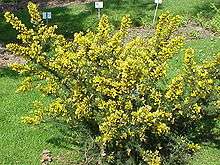Ulex europaeus
| Common gorse | |
|---|---|
 | |
| Common Gorse flowers | |
| Scientific classification | |
| Kingdom: | Plantae |
| (unranked): | Angiosperms |
| (unranked): | Eudicots |
| (unranked): | Rosids |
| Order: | Fabales |
| Family: | Fabaceae |
| Subfamily: | Faboideae |
| Genus: | Ulex |
| Species: | U. europaeus |
| Binomial name | |
| Ulex europaeus L. | |
Ulex europaeus (gorse, common gorse, furze or whin) is a species of flowering plant in the family Fabaceae, native to portions of Europe from the northern United Kingdom south to Portugal, and from the western Republic of Ireland east to Galicja in Poland and Ukraine.
Description

Growing to 2–3 metres (7–10 ft) tall, it is an evergreen shrub. The young stems are green, with the shoots and leaves modified into green spines, 1–3 centimetres (0.39–1.18 in) long. Young seedlings produce normal leaves for the first few months; these are trifoliate, resembling a small clover leaf.
The flowers are yellow, 1–2 centimetres (0.39–0.79 in) long, with the pea-flower structure typical of the Fabaceae; they are produced throughout the year, but mainly in early spring. The fruit is a legume (pod) 2 centimetres (0.79 in) long, dark purplish-brown, partly enclosed by the pale brown remnants of the flower; the pod contains 2-3 small blackish, shiny, hard seeds, which are ejected when the pod splits open in hot weather. Seeds remain viable for 30 years.
Like many species of gorse, it is often a fire-climax plant, which readily catches fire but re-grows from the roots after the fire; the seeds are also adapted to germinate after slight scorching by fire. It has a tap root, lateral and adventious roots. An extremely tough and hardy plant, it can live for about thirty years.
Invasive Species
The species has been introduced to other areas of Europe, and also to the Americas, New Zealand, South Africa, and Australia,[1][2] where it is often considered a weed and is a serious problem invasive species in some areas (notably the western United States, Chile and New Zealand). It was introduced to New Zealand from Scotland as a type of hedge, but became a major blight to farmers as the climate suited its growth better than its native habitat and many of its natural predators were absent.
Common gorse is also an invasive species in the montane grasslands of Horton Plains National Park in Sri Lanka. It outcompetes native, endemic species and is a fire hazard.[3]
Biological pest control is used on this plant in many areas. The gorse spider mite (Tetranychus lintearius) and the gorse seed weevil (Exapion ulicis) reduce the spread of the plant.
Cultivation
This plant is used for hedging, boundary definition and groundcover in suitably sunny, open locations. Cultivars include 'Strictus' (Irish gorse), a dwarf form, and the double-flowered, non-fruiting 'Flore Pleno', which has gained the Royal Horticultural Society's Award of Garden Merit.[4]
Other uses
Bruised gorse was used in some areas for feeding to horses and other livestock.[5]
Lectin extracted from seeds of this species binds to, is remarkably specific for, and is the standard method for identification of H-substance (absent in the hh antigen system) on human red blood cells. The vast majority of humans express H-substance, which is the basis for the ABO blood group system, but a few rare individuals ("Bombay phenotype") do not—and a chemical isolated from Ulex europaeus is used to identify these individuals.
It fixes nitrogen into the soil.[3]
See also
References
| Wikimedia Commons has media related to Ulex europaeus. |
- ↑ "Weeds of National Significance (WONS)". www.environment.gov.au. Commonwealth of Australia - Department of the Environment and Energy. Retrieved 30 November 2016.
- ↑
- 1 2 Lalith Gunasekera, Invasive Plants: A guide to the identification of the most invasive plants of Sri Lanka, Colombo 2009, p. 88–89.
- ↑ "RHS Plant Selector - Ulex europaeus 'Flore Pleno'". Retrieved 7 June 2013.
- ↑ Aiton, William (1811). General View of The Agriculture of the County of Ayr; observations on the means of its improvement; drawn up for the consideration of the Board of Agriculture, and Internal Improvements, with Beautiful Engravings. Glasgow. p. 441